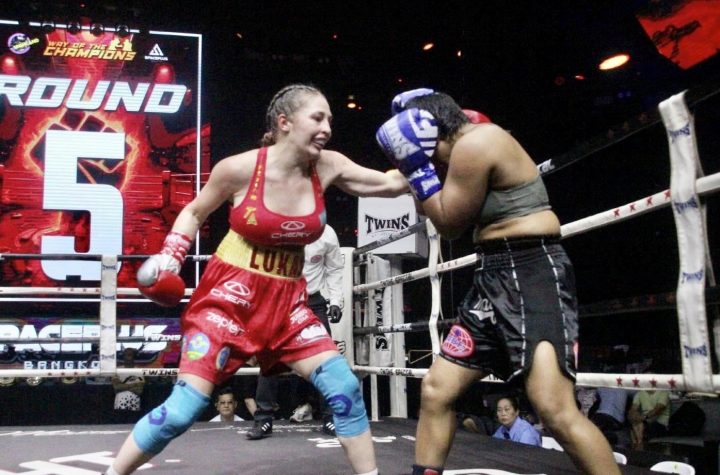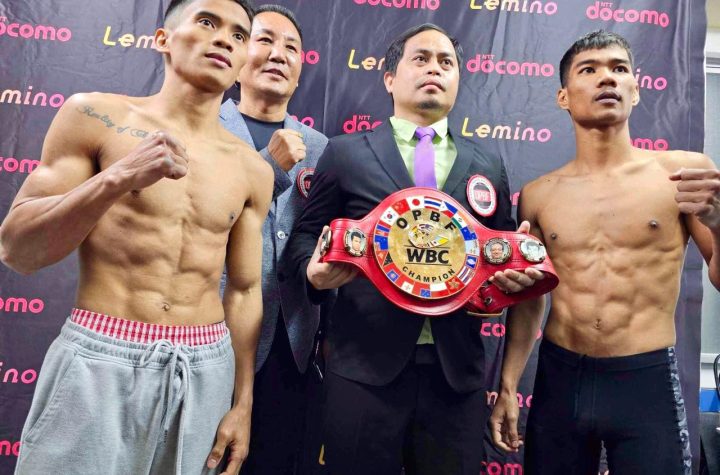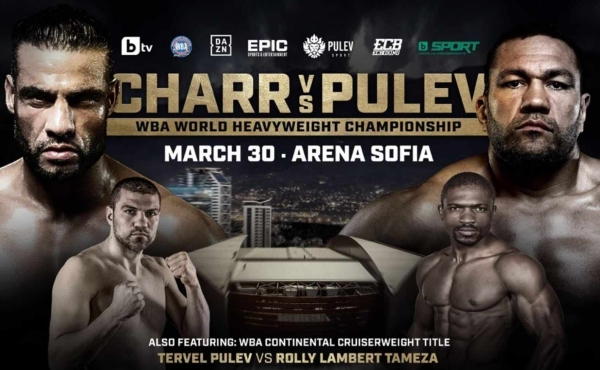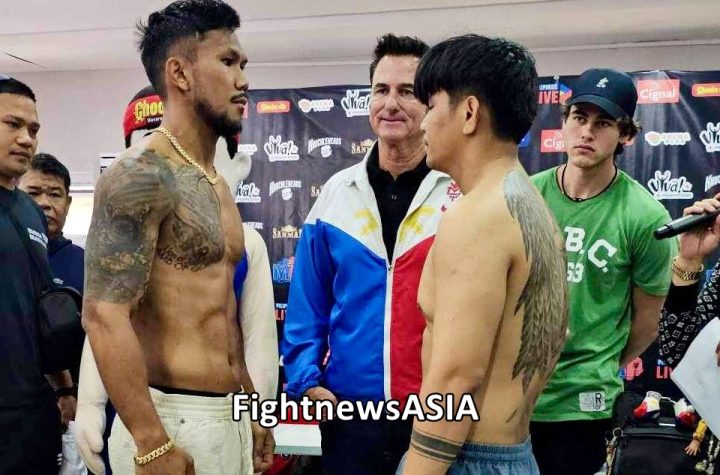
By Scott Christ
Badlefthook.com
Let’s be honest: most serious boxing fans have laughed off Amir Khan’s coming April 20 shot at WBO welterweight titleholder Terence Crawford, and they’ve got their reasons.
For one thing, it’s a major pay-per-view main event, and at this point, Khan (33-4, 20 KO) is only a major pay-per-view main event fighter by the loosest, most desperate definition.
There were once big dreams of Khan — a celebrated prospect and 2004 Olympic silver medalist — becoming an elite-level superstar in the sport.
Then Breidis Prescott knocked him out in 54 seconds. That was almost 11 years ago.
A controversial loss to Lamont Peterson in 2011 derailed the train again, and that was followed by a knockout loss to Danny Garcia in 2012. In 2016, he made the daring (or insane, depending how you want to look at it) move up to a 155-pound catchweight to face Canelo Alvarez in an HBO pay-per-view main event. He boxed well early, as he usually does. And then he was predictably flattened in the sixth round, a true highlight reel knockout for the bigger Mexican.
Khan, now 32, has had a good professional career. He did not and almost certainly will never achieve all the glory that was imagined for him in the early days, but over the last nearly 14 years, he’s been a name fighter in the sport. He won world titles at 140 pounds. He’s fought big names and top fighters — Marco Antonio Barrera, Paulie Malignaggi, Marcos Maidana, Zab Judah, Peterson, Garcia, Devon Alexander, Canelo. Some of them were past their best days. A couple of them knocked him silly or cold. But he fought them, and he fought them as a headline fighter.Fair or not, Khan has long been a target for fan ridicule, as many of his statements are seen as arrogant at best, delusional at worst.
Fair or not, Khan has long been a target for fan ridicule, as many of his statements are seen as arrogant at best, delusional at worst. And even without all that, boxing fans can be an incredibly unforgiving sort.
To many of them, either you’re great or you’re trash. As soon as someone loses, they suck and they always sucked and they’ll always suck; and if they don’t dare to fight anyone who can actually beat them, they suck then, too. This attitude is perhaps lessening a bit in recent years, but it’s still out there.
Khan has had a well-managed career for the most part. That is often code for “been steered clear of challenges,” but he’s taken some risks, too, and later this month, he’ll take another.
After Prescott sent him to another dimension in 2008, Khan fought a series of relatively safe opponents, with his team doing a very good job of keeping him active to rebuild his confidence.
He smashed Oisin Fagan in his return bout, then three months later faced Mexican legend Marco Antonio Barrera, who was 35 years old and fought Khan at 135 pounds. Barrera’s best years had come nearly a decade earlier at 122 pounds.
Making matters even worse, Barrera had recently taken a tune-up in Mexico against a late notice goon named Freudis Rojas, who headbutted Barrera for a third round DQ, opening up a severe gash that hadn’t healed by the time he fought Khan. As a result, Barrera wound up busted open again, badly, and the fight went to a technical decision in the fifth. The whole thing was a farce. (Rojas, if you’re wondering, never fought again.)
They did step up the competition after Barrera, but the handlers did it wisely, putting Khan in against three straight opponents — Andriy Kotelnik, Dmitriy Salita, and Paulie Malignaggi — who had some skills but no punching power. Khan routed them all, beating Kotelnik by wide decision, taking the overmatched Salita out in one, and dominating Malignaggi en route to an 11th round stoppage.
:no_upscale()/cdn.vox-cdn.com/uploads/chorus_asset/file/16004231/107535218.jpg.jpg)
In Dec. 2010, though, he took a risk. Khan had won the WBA “world” title at 140 pounds with the win over Kotelnik in July 2009, and now a mandatory fight with Marcos Maidana was calling. Maidana didn’t have the skills of Khan, or the skills of Kotelnik or Malignaggi. But he had the one thing that had proven Khan’s kryptonite already: raw power.
We also knew that Maidana was a fighter who would walk through hell to win. We’d seen proof of that in 2009, when he upset Victor Ortiz on HBO. Ortiz and Maidana both went down in the first round, then Ortiz dropped Maidana two more times in the second. But Maidana wouldn’t go away, shook Victor’s confidence, and beat him up. After going down in the sixth, Ortiz quit.
Fight night came, and Khan started fast, dropping Maidana with a vicious body shot combo in the opening round. It really could have ended there, and against most fighters, it probably would have. But Maidana was not most fighters; he got to his feet and took the fight to Khan.
For me, that fight was Amir Khan’s greatest hour. He was matched with a guy it was reasonable to expect would simply overpower him eventually, and not only did he survive 12 rounds and win the fight, but he took a lot of good shots to do it. He was badly hurt in the 10th round, but managed to survive it. It was a terrific fight, action-packed with sincere gut checks from both men.
From there, Khan went back to the United Kingdom for the first time in two years and made a successful defense against Paul McCloskey. Zab Judah was next, three months later in Las Vegas. Khan knocked him out in the fifth round, gaining the IBF junior welterweight title.
Then came the Peterson fight. Whatever the many controversies, Khan ultimately lost a close decision that stands on the books, and dropped his belts. The loss didn’t stop him from getting a fight with WBA “super world” and WBC titleholder Danny Garcia, though, since so many felt Khan had been jobbed against Peterson. Khan fought well for a couple rounds, got dropped in the third, and then was finished in the fourth after two more knockdowns.
Once more, Amir Khan was on the comeback trail. He started with Carlos Molina, an unbeaten/untested opponent. Khan dominated, stopping Molina after 10. Former lightweight titleholder Julio Diaz followed, as Khan went back to the UK again. Diaz gave Khan hell, dropping the favorite in the fourth round. Khan did win on the cards, but it was a closer call than expected.
He’d taken the fight with Diaz at a catchweight between 140 and 147, and decided to fully move up to the welterweight division. He faced Luis Collazo, Devon Alexander, and Chris Algieri in 2014-15, similar in style matchup to his prior run against Kotelnik, Salita, and Malignaggi. Like those guys, this trio were good boxers who presented no real challenge for Khan on paper. They weren’t punchers, and nothing they did well made them any threat to Khan, who generally did the same things, but better. He beat them all by decision.
Khan sat out from May through the rest of 2015. He’d been trying for years to land a big money showdown with either Floyd Mayweather or Manny Pacquiao, coming up empty. Every time it looked like he might have a path to one of those fights, it fell apart.
But he finally got his mega-fight. On February 2, 2016, the boxing world was rocked when it was announced that WBC middleweight champion Canelo Alvarez would be facing Khan on May 7. Unlike basically every single fight announced these days, it wasn’t a fight that was so much as rumored beforehand; it truly came out of left field.
Khan moved up to 155 pounds. He talked a great game leading up to it, claiming confidence that he could take Canelo’s power. Friends like Tyson Fury and David Haye talked up Khan’s chances at the upset. Boxing fans, for what it’s worth, mostly laughed off the idea that Khan, who was chinny 20 pounds south, could move up to middleweight and deal with Alvarez.
Once the bell rang, Khan was quicker than Alvarez, no doubt, which was expected. Scores after five rounds were 48-47 Khan, 48-47 Alvarez, and 49-46 Alvarez, the last one questionable. Khan was competitive, boxing nicely, avoiding Alvarez’s power, using his speed. It still felt, though, that any single punch could end the fight.
Then it happened. Alvarez landed the bomb. Khan went down. Khan was done. 2:37, round number six.
:no_upscale()/cdn.vox-cdn.com/uploads/chorus_asset/file/9909941/529042992.jpg.jpg)
Amir Khan pretty much disappeared from the sport for about a year after that. He did some reality show in the UK, the details of which I do not really know and also don’t care to learn. It did get him a lot of headlines, though. Something about how being in a reality TV jungle taught him lessons. He ate bugs. I don’t know.
Khan eventually signed a three-fight deal with Eddie Hearn’s Matchroom Boxing and returned to the ring in April 2018, facing Phil Lo Greco, a Canadian also-ran best known for being friends with Paulie Malignaggi. Lo Greco was designed as a soft touch to get Khan back in the ring, and he was, as Khan wiped him out in 39 seconds.
Samuel Vargas came next in September. By now, the idea Matchroom had was crystal clear and nobody was pretending it was anything else. Khan and longtime press rival Kell Brook — rehabbing from back-to-back, physically damaging losses to Gennady Golovkin and Errol Spence Jr — would each fight twice in 2018, then finally square off in 2019 for a big money fight in England.
Khan, though, got a little shock to the system. He dropped Vargas in the second, but got cocky and Vargas put him down late in the same round. Khan knocked Vargas down again in the third, but ultimately settled for a wide decision, backing off the attack and fighting smart over the remainder of the bout. Vargas was out of his depth with Khan; if Khan didn’t do anything foolish, Vargas couldn’t really touch him. Mostly, Khan did nothing foolish after that eye-opener in the second frame.
It’s worth wondering if that little scare against the lightly-regarded Vargas changed the plans immediately, or if that came over time, from a combination of factors. Brook didn’t look great in his December win over Michael Zerafa, but Brook-Khan — or Khan-Brook, whatever — was still a big UK fight. They both were going to make big money to finally settle things.
The Brook and Khan sides went back-and-forth quibbling about some of the details of any potential fight — weight and whatnot — and it was obvious that it wasn’t quite the done deal Hearn had hoped it would be once 2018 closed.
Then Top Rank came calling. They needed an opponent for Terence Crawford. They offered to overpay, frankly, for Amir Khan’s services. Khan told Eddie Hearn that Crawford, not Brook, was the fight he wanted. Hearn, seemingly dejected when speaking about it all, let go of the Khan-Brook/Brook-Khan dream. It was back to the States for Amir Khan.
If you’re looking at it the way Amir Khan does, it’s all pretty simple.
Fighting Kell Brook is a big fight in the United Kingdom, and American diehards would care, but it’s no blockbuster attraction here, certainly not a pay-per-view main event. Brook (38-2, 26 KO) looks past his best days. There’s no world title to be won fighting Kell Brook. No massive glory to attain.
And, frankly, Khan might lose to Brook. So if Amir Khan is going to take that level of risk at this stage, he would prefer to do it against Terence Crawford.
Crawford is in-prime, regarded as one of the two best fighters in the sport pound-for-pound, and it’s for a world title. It’s also on U.S. pay-per-view, in the main event.
Khan hasn’t held a world title since 2011. He has only headlined one U.S. pay-per-view, against Canelo in 2016, and that easily could have been the first and last time he did so, given the result.Khan’s been in the game for almost 14 years now. We know what he can do. We also know what he can’t do.
Another world title shot. Another chance to be in the main event on pay-per-view. One more shot at being the star he was supposed to be all those years ago.
Fans, though, are right to balk at the matchup, and especially at being asked to pay a pay-per-view fee to see it. Khan has never won on this level before, and his last really serious fight was against Alvarez, which was three years ago.
At best, it’s imagined that Khan will look competitive early against Crawford, and then Crawford will do what Crawford does, and Khan will get knocked out in time. Like he did against Danny Garcia. Like he did against Canelo Alvarez.
Khan’s been in the game for almost 14 years now. We know what he can do. We also know what he can’t do.
Top Rank’s desperation for a credible Crawford opponent became Khan’s opportunity, and fair enough for Khan. But that doesn’t mean the paying customer should be expected to get stoked on what is seen as a predictable outcome.





More News
Marcial vs Sinam in Manila
Era, Lukas, Innes Win in Thailand
Vitor vs Kim in Bohol